William S. Powell Jr. must have been mighty proud to be a Tuskegee Airman. He kept his brown leather flight jacket with the 99th Pursuit Squadron patch, his helmet, his graduation diploma, flight wings, training manuals, photographs, dog tag and medals.
Powell graduated from the Tuskegee pilot program in 1945 as a flight officer trained to fly single-engine P-47 and P-51 planes. He was assigned to the 99th, which two years before had become the Army Air Force’s first African American squadron. Powell graduated several months before World War II ended and seemingly too late to join the fighting in Europe.
Last weekend, 75 pieces of his Tuskegee gear ended up in an auction in Lone Jack, MO. How in the heck did they end up there, nearly a thousand miles from his birth state of New York? I wondered.
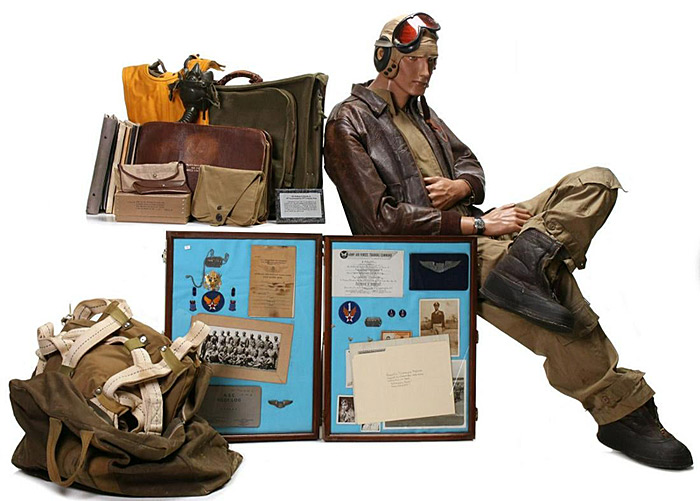
I shouldn’t have been surprised, though. I’ve picked up some great items at auction and wondered how they ended up there and miles away from their original owner. In particular were two large portfolios of artist/illustrator Bill Howell, who was part of the Black Arts Movement of the 1960s.
Powell’s items came from the World War II collection of retired US Army Lt. Col. John R. Angolia, who has been collecting for the last 75 years. The grouping was among a mass of items from Angolia’s private collection, which had been in a museum in his home in Kansas City, MO.
The auction also included memorabilia from Admiral John S. McCain Sr., a heavily decorated World War II officer and the first of a military family that spanned several generations. He was the father of Admiral John S. McCain Jr. and grandfather of John S. McCain III, the U.S. senator and 2008 presidential candidate who had served in Vietnam. The grouping included the elder McCain’s uniform, certificates and citations, medals and much more.
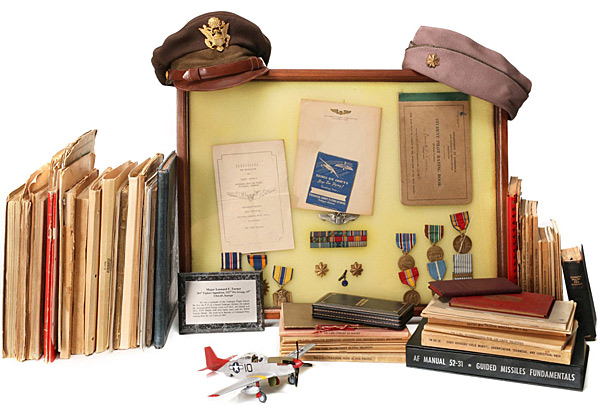
Powell’s was not the only Tuskegee Airman stash in the auction. A smaller grouping had belonged to Leonard F. Turner, who was a member of the all-black 301st Fighter Squadron of the 332d Fighter Group. His lot included medals, including the Distinguished Flying Cross; manuals; pilot wings; a Red Tails model airplane; yearbooks and photos. The 332d pilots were known as the “Red Tails” because they painted the tails of their P-47 planes the color red. The unit consisted of the 99th, 100th, 301st and 302d fighter squadrons.
The artifacts from Powells’ military service were valued at $40,000 to $60,000, and the bidding started at $20,000. They did not sell. Turner’s lot sold for $2,200 (without the buyer’s premium of 18 percent). McCain’s sold for $42,000 (without the buyer’s premium).
Powell and Turner were among the more than 990 pilots and 14,000 support personnel who came through the Tuskegee Air Field in Alabama during World War II. The support group included bombardiers, engineers, navigators, and maintenance and supply people.
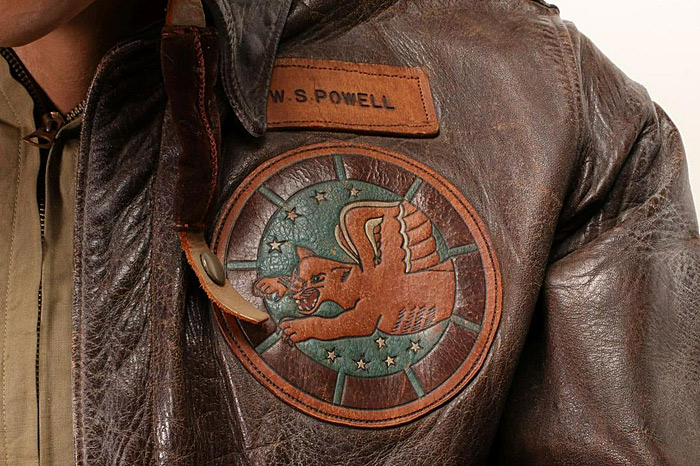
Powell was from Eggertsville in the town of Amherst, a suburb of Buffalo, NY. He was born in 1925 in Lockport, NY, and his family moved to Eggertsville when he was a young child, according to a biography in the Fall/Winter 2019 newsletter of the Afro-American Historical Association of the Niagara Frontier Inc. He attended the University of Buffalo before enlisting in the Army. Powell graduated from the Tuskegee program in April 1945 as a flight officer. He was assigned to the 99th Pursuit Squadron, 477th composite Wing (Group), according to the auction house. The Japanese surrendered in August, ending the war.
Two years before, the earliest of the 99th Pursuit Squadron pilots had headed off to Europe. They participated in fighting first in Italy and later in North Africa and across Europe. The 99th was eventually renamed the 99th Fighter Squadron of the 332d Fighter Group, which flew 3,000 missions in their red-tailed planes.
After Powell left the military, he earned bachelor’s and master’s degrees from the University of Buffalo. He was a probation officer in Washington, DC, and was later appointed director of federal probation in Buffalo, a job from which he retired. Powell died in 1996.
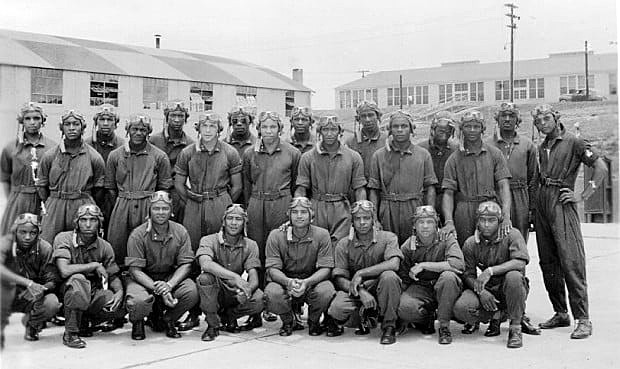
Turner arrived at Tuskegee from Washington, DC, and apparently was joined by his twin brother Leon L. Turner. They both attended Howard University, a family member noted in an essay. Leonard entered the Tuskegee program in 1942 as a cadet and graduated in June 1943 as a second lieutenant. As a member of the 332d, he was sent overseas. There, he and the other Tuskegee-trained pilots, whom the military had dismissed as incapable of flying aircraft, performed superbly.
On Oct. 12, 1944, Leonard Turner was among the pilots who bombed railroad traffic from Budapest to Bratislav for two consecutive days. Six pilots with the 302d shot down nine enemy planes. One member of the 100th was shot down that day. Turner was one of nine pilots of the 332d who received the Distinguished Flying Cross in 1945.
“Lt. Turner was one of those many unfortunate pilots who fought gallantly as a member of the 332nd but received little publicity because he failed to register an aerial victory,” wrote Charles Francis in his 1997 book “The Tuskegee Airmen: The Men who Changed a Nation.” Francis listed Turner as one of the unsung heroes who were “the backbone of their organizations and were considered by their comrades as the most capable and dependable pilots of their outfits.”
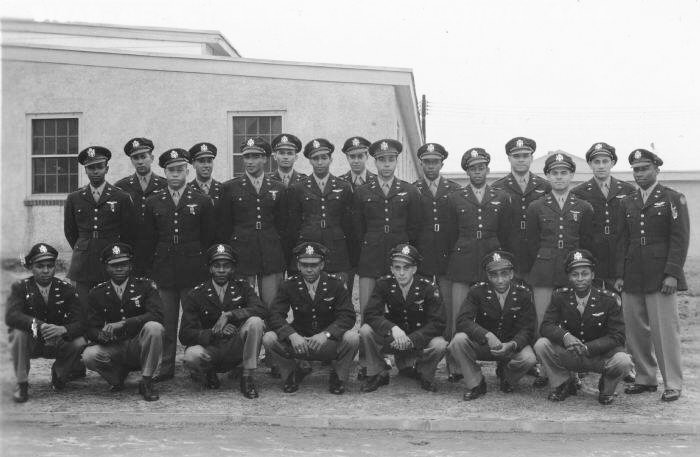
Leonard Turner flew 70 missions during the war and returned to the United States in December 1944. In addition to the Flying Cross, he was also awarded the Air Force medal with four oak leaf clusters and the European campaign ribbon with four battle stars. He became a command pilot and retired from the Air Force in 1967, according to the auction house.
Turner was also listed as an active duty officer, a captain, in the US Air Force in a 1960 manual assembled by the Department of Defense. The auction house described him as a major.
His brother Leon graduated in January 1944, also as a second lieutenant and a pilot of twin-engine planes. I could find only a bit of information about him, including a photograph of his graduating team of men who had received advanced pilot training. There were no IDs on the photo. “The men who graduated as Single Engine pilots would be eventually sent to Italy to join 332nd Fighter Group, while the men who graduated as Twin Engine pilots would stay here in the United States and train as members of the 477th Bombardment Wing (Group),” according to the Facebook page of the Tuskegee Airmen National Historic Site.
Francis’ book also contains an undated photo of Leon with his mother as she admired his gunnery medal.
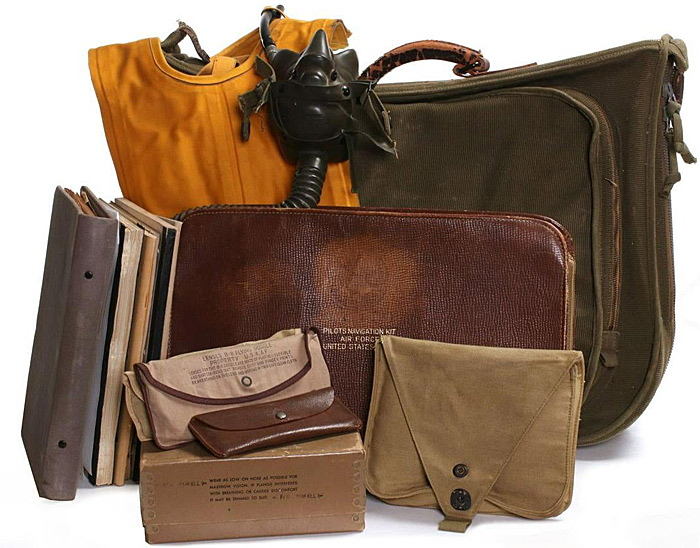
Curious about how the Tuskegee Airmen artifacts found their way to auction, I contacted Angolia by email. He obligingly answered that question and others, as shown below with minor editing. Angolia has published nearly three dozen books on World War II.
How did you acquire Powell and Turner’s military items?
“Both were obtained in the early 60s from the same source. (The) groupings had been purchased by an avid collector in Texas. He died, and it was left to his wife to dispose of. I visited with her, I inspected the groupings, and we arrived at a price, and has been with me up until the 1 August (2020) auction.
“Only the Turner grouping sold at auction, and the Powell grouping was passed on. I came home, made a single phone call to a neighbor regarding the Powell grouping, and he purchased the entire lot. He will keep it for two or three years, and then will donate the entire grouping to the Smithsonian to join an already existing Tuskegee display.” (The Smithsonian’s National Museum of African American History and Culture in Washington has some artifacts pertaining to the Tuskegee Airmen.)
Do you have other Tuskegee Airmen items?
“These two groupings were the only ones in my collection as I never encountered others since.”
How did you get started as a collector of WWII military items?
“Because I grew up during WWII, and residing in Washington, D.C. By 1944, the city was awash with personnel in uniform, and Walter Reed Army Hospital was receiving the wounded. I lived two blocks away from the hospital and was there every day to run errands for the patients. This was the start of my interest in military history. When the war ended, the Vets came home in droves, bringing with them souvenirs from their battles. Since these were everywhere, I began collecting them. I collected U.S. items for about three years, but these were so plentiful that I opted to collect Third Reich (TR) items as I don’t like to take the easy way in life.
“From 1947 to 1997, I built one of the five largest TR collections in the world. I wrote a large number of books on the wartime history of Nazi Germany during this period. That same year I attended the 50th Anniversary of the D-Day Invasion as a guest speaker. Surrounded by so many Allied Vets, especially the paratroopers, I decided that I had been remiss in the writing of our own history. Almost immediately, I divested my entire TR collection, and shifted my attention to WWII once again. This was followed by the publishing of a four-volume study entitled “Heroes In Our Midst.”
Why are you selling off your collection now? Are you keeping anything?
“At 84.5 years old, I was thinking that should I die before my wife, she would be left with the disposal of the collection. She knew nothing about what the items were or their value. … The collection was not sold to reap the rewards as I have been very blessed in life, but rather put the collection into the hands of like historians.
“Once a collector, always a collector! I have retained all my personal (save for the three groupings that went to auction), which will go to my son. I will continue to collect small items such as cased/boxed medals, badges, cloth insignia, etc – small items that will be easy to display in a single room.”
Have you donated any items to other museums?
“Certainly!”
How did you acquire the John McCain Sr. items? Why do you think they sold so well?
“I obtained this as a lot from a single source. The grouping is a fantastic piece of history. He commanded all aviation in the Pacific and West Coast.”

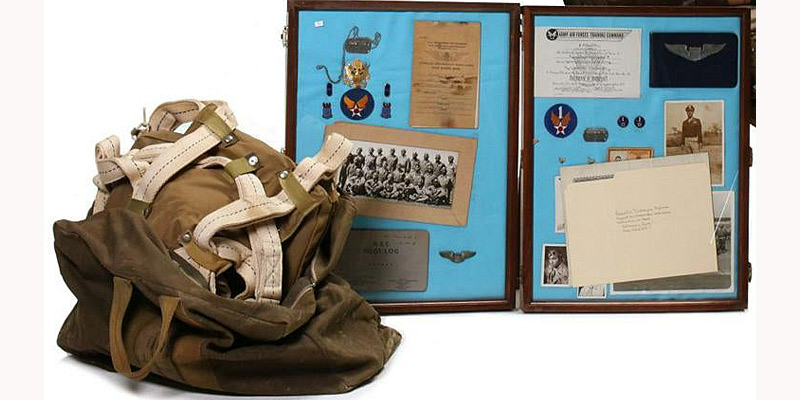
[…] Historically Speaking – AAHANF MyAuctionFinds.com […]